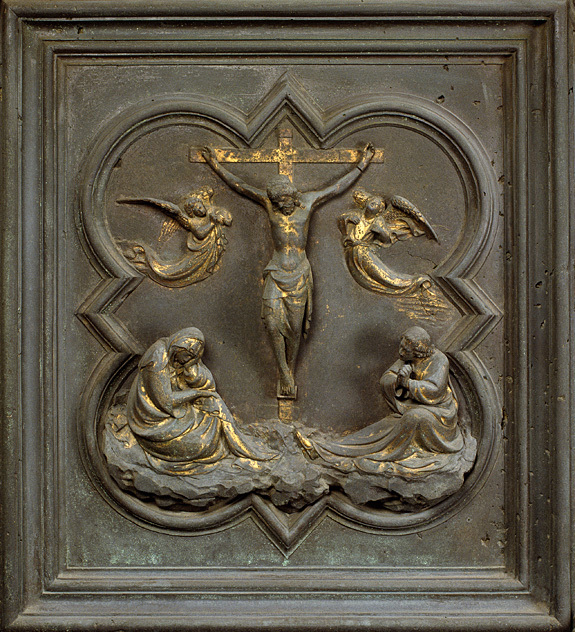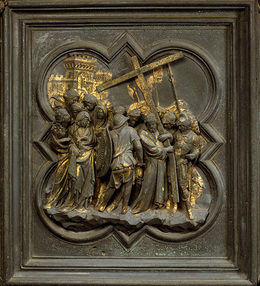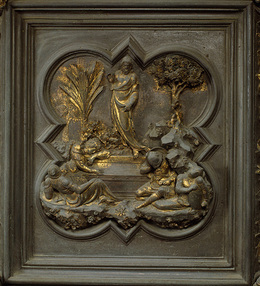Panel XVIII - The Crucifixion
Panel details:
The death of Christ fulfils the promise of redemption from sin and is represented as the payment of a ransom (lùtron). Redemption signified the payment of a price to free those in bondage. In the first century this word was used to indicate the liberation of slaves or prisoners.
The crucifixion of Jesus is narrated in the Gospels, Matthew 27.33 to 50; Mark 15.22 to 37; Luke 233.33 to 46; John 19.18 to 30.
Isaiah 53,6-7 “All we like sheep have gone astray; we have turned every one to his own way; and the Lord hath laid on him the iniquity of us all. He was oppressed, and he was afflicted, yet he opened not his mouth: he is brought as a lamb to the slaughter, and as a sheep before her shearers is dumb, so he openeth not his mouth”.
Mark 10-45 “For even the Son of Man did not come to be served, but to serve, and to give His life a ransom for many”. The crucifixion of Jesus is central to the culture of Christianity, as it is the symbol and at the same time it is emblematic of the birth of Christianity, which has been an enormous cultural influence throughout history. The cross, which is itself the basis of the crucifixion, became a symbol that is still used extensively in all Christian cultures. The word cross probably originated from the Sanskrit, “krugga“, meaning stick or pastoral staff. The Greeks call it “post” and the Jews call it “tree”. All these terms denote the ancient origin of the cross as a punishment, to which the condemned were nailed or impaled. The crucifixion took place on a small hill to the north of Jerusalem, called Calvary in Latin and Golgotha in Aramaic, near one of the entrances to the city.
Art works in the third century represented only the Greek cross. In the fourth century works of art began depicting the Christo gram, a symbol formed by the union of the Greek letters Χ (chi) and Ρ (rho). In this same period, the death of Christ is symbolically represented in the figure of the Lamb of God, as artists generally preferred the symbolic to the realistic representation. The cross invokes an infamous method of torture and it was only in the years following the edict of Theodosius (380) and the spread of Christianity that artworks depicted symbols of triumph. The oldest documented depiction of the crucifixion is perhaps the third century graffiti, called Alexamenos graffito.
The subject of the crucifixion begins to be depicted starting in the fifth century. here below it is represented in a relief on the wooden door of the Church of Santa Sabina in Rome.
Initially, the cross alone was depicted, while the crucifix was introduced much later. The Council in Trullo, in a.d.692, imposed the representation of the crucifixion as the emblem of the cult and the council elected to illustrate it figuratively in the form of a crucifix, as it had already appeared in the miniature of the Rabbula gospels (now in the Laurentian Library in Florence, Italy), depicting Christ as calm, serene and triumphant.
Subsequently to the decisions of the Council in Trullo, representations of the crucifix followed two distinct iconographic typologies: the “Christus triumphans” of Byzantine origins, represented triumph over death. Christ has his eyes open, his head erect, sometimes wearing a royal crown, and there are no visible signs of distress on the body. the feet are parallel and give the figure of Jesus an upright, majestic stature. The detail of the feet nailed separately on the platform will be lost starting in the fourth century. The relaxed face and body showing no suffering symbolized the triumph of Christ, who has conquered death. This is the reason why there is not a crown of thorns depicted on his head, but rather a golden halo. This iconographic scheme will continue in western art until the thirteenth century.
“Christus patiens” begins being depicted in the tenth century. Jesus is represented dying or dead, and his facial expression is tensed in pain and suffering. He is wearing the crown of thorns on his head, his face is bloodied and he is in agony. His legs are bent and his feet are placed one on top of the other, pierced by a single nail; his stomach is rigid because of his severe suffering. One of the first examples of this type of iconography is the gero crucifix, located in the Cologne Cathedral, which specifically highlights the human dimension of Christ who suffered and faced death, never revealing his divinity.
Ghiberti created his crucifixion for the North Door of the Baptistery in Florence prior to 1415. The characteristics of the composition are typical of the first stages of work, with clear references to gothic art. Naturalism subsides and the body of Christ does not have perfect classical proportions or expressions of tension. The rhythm of the work is given both by its linear composition and by the drapery that does not flow gracefully, but rather follows the effects of the more abstract frame. The symmetrical figures of the angels on either side of Christ are elegant and are in contrast with the upper lobes of the frame. The mourners, the Madonna and st John, also placed in calculated symmetry, are at the foot of the cross, seated on a rocky base, which is a clear reference to the landscape of rocks present in the panel of the sacrifice of isaac. Despite the suffering of the figures, the composition has a celebratory and majestic setting, as Ghiberti chose to place Christ at the centre of the panel, seeming to emerge from a curtain formed by the drapery of the figures around him.
The iconographic novelty and importance of Ghiberti’s work became an inspiration for other artists of the same period. A case in point were the panels for the Altar of San Bernardo in the Cathedral of Teramo, sculpted by Nicola da Guardiagrele (1385-1462), who was the most important goldsmith, painter and sculptor in Abruzzi in the fifteenth century. The decorative panels of the frontal were made shortly after Ghiberti finished his crucifixion and perhaps also by the same sculptor who created the stone ones located in the Museum dell’Opera del Duomo in Florence. In this case, the representation follows the iconography of Ghiberti precisely, except for the two angels, and of course, the elegance of Ghiberti’s work.
There have been numerous masterpieces representing the crucifixion over the centuries that have left an everlasting mark in the history of art.



